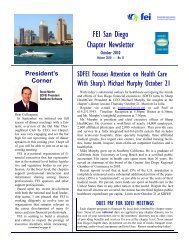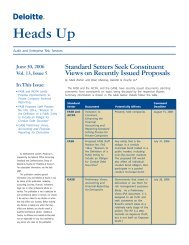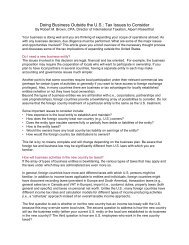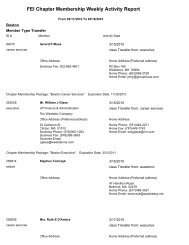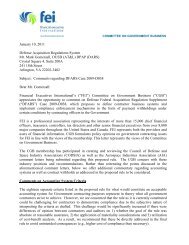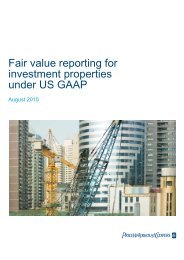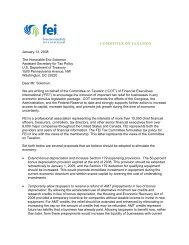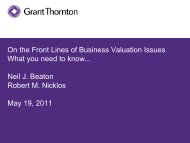U.S. GAAP v. IFRS: The Basics - Financial Executives International
U.S. GAAP v. IFRS: The Basics - Financial Executives International
U.S. GAAP v. IFRS: The Basics - Financial Executives International
Create successful ePaper yourself
Turn your PDF publications into a flip-book with our unique Google optimized e-Paper software.
Employee Benefits Other Than<br />
Share-Based Payments<br />
Similarities<br />
Multiple standards apply under U.S. <strong>GAAP</strong>, including FAS 87 Employers’ Accounting for Pensions,<br />
FAS 88 Employers’ Accounting for Settlements and Curtailments of Defined Benefit Pension Plans<br />
and for Termination Benefits, FAS 10 Employers’ Accounting for Postretirement Benefits Other<br />
than Pensions, FAS 112 Employers’ Accounting for Postemployment Benefits, FAS 1 2 (Revised)<br />
Employers’ Disclosures about Pensions and Other Postretirement Benefits, and FAS 158 Employers’<br />
Accounting for Defined Benefit Pension and Other Postretirement Plans. Under <strong>IFRS</strong>, IAS 19<br />
Employee Benefits is the principal source of guidance for employee benefits other than share-based<br />
payments. Under both <strong>GAAP</strong>s, the periodic pension cost under defined contribution plans is based<br />
on the contribution due from the employer in each period. <strong>The</strong> accounting for defined benefit plans<br />
has many similarities as well. <strong>The</strong> defined benefit obligation is the present value of benefits that<br />
have accrued to employees through services rendered to that date, based on actuarial methods of<br />
calculation. Additionally, both U.S. <strong>GAAP</strong> and <strong>IFRS</strong> provide for certain smoothing mechanisms in<br />
calculating the period pension cost.<br />
Significant Differences<br />
Actuarial method<br />
used for defined<br />
benefit plans<br />
Valuation of defined<br />
benefit plan assets<br />
Treatment of actuarial<br />
gains and losses for<br />
annual pension cost<br />
Amortization of<br />
deferred actuarial<br />
gains and losses<br />
U.S. <strong>GAAP</strong> <strong>IFRS</strong><br />
Different methods are required dependent on<br />
the characteristics of the benefit calculation<br />
of the plan.<br />
Valued at “market-related” value (which is<br />
either fair value or a calculated value that<br />
smoothes the effect of short-term market<br />
fluctuations over five years) within three<br />
months of the balance sheet date. (Note: for<br />
fiscal years ending after December 15, 2008,<br />
the valuation must be done as of the balance<br />
sheet date.)<br />
May be recognized in income statement<br />
as they occur or deferred through either a<br />
corridor approach or other rational approach<br />
applied consistently from period to period.<br />
Over the future service lives of employees or,<br />
for inactive employees, over the remaining life<br />
expectancy of those participants.<br />
4 u.s. gaaP v. iFrs: t h E <strong>Basics</strong><br />
Projected unit credit method is required in all<br />
cases.<br />
Valued at fair value as of the balance sheet<br />
date.<br />
May be recognized in the income statement<br />
as they occur or deferred through a corridor<br />
approach. If immediately recognized, can elect<br />
to present in either the income statement or<br />
the SORIE.<br />
Over the average remaining service period (that<br />
is immediately for inactive employees).



